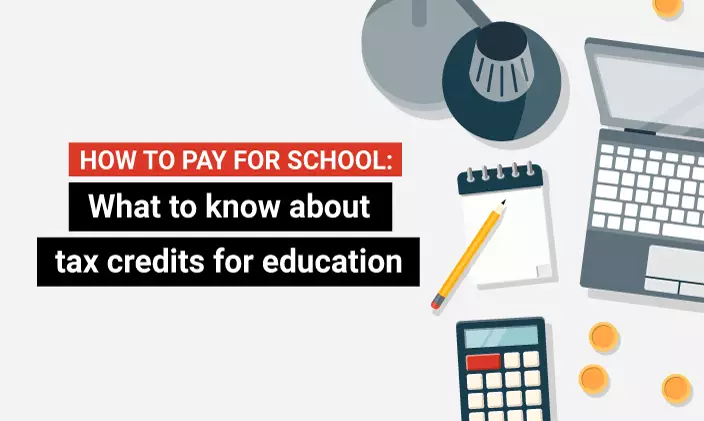What to know about tax credits for education

Written by Michael Feder

Reviewed by Chris Conway, Director of Financial Education Initiatives and Repayment Management

In this article, we’ll cover the two major federal tax credits for education: the American opportunity tax credit (AOTC) and the lifetime learning credit (LLC). We’ll explore the differences between the two as well as how you can begin the application process.
Please note the intent of this article is to provide a general overview of income tax credits related to qualified educational expenses. Please seek the advice of a tax professional before taking a tax position.
Tax credits vs. tax deductions: What's the difference?
It’s important to understand the difference between a tax deduction and a tax credit. A tax deduction reduces the amount of income that’s eligible for taxation. While education expenses can entitle you to some tax deductions, that is not the subject of this article. You can find more information about tax deductions for education on the IRS website .
Tax credits, on the other hand, enable taxpayers the ability to claim a certain amount as a qualified expense. For every dollar that qualifies, your tax obligation can be reduced by the same amount. This allows you to get a bit more bang for your buck, compared to a tax deduction.
What is an education tax credit?
Education tax credits incentivize students to pursue higher education by reducing their tax obligation. The amount of this reduction is based on the money the taxpayer has put toward their education ; it is matched dollar for dollar up to a specified amount.
There are two federal education tax credits: the AOTC and the LLC.
How do tax credits for education work?
Tax credits can be claimed by anyone paying for education and filing a tax return. This can include students (if they’re financing their own education and filing a tax return) or the parents or guardians of students, but not dependents.
A number of requirements apply generally to both the AOTC and LLC. These are:
- The claimant pays for education expenses that qualify for the tax credits.
- The student is enrolled in an educational institution that’s eligible for the tax credits.
- The student is the claimant, or they’re the spouse or dependent of the claimant.
You may be disqualified from one of these education tax credits for reasons such as:
- Being claimed as a dependent on someone else’s tax return
- Claiming a tax credit for a spouse when that spouse files separately
- You already claimed the benefit during the same eligibility period
What is an eligible expense for an education tax credit?
Generally speaking, these credits cover tuition costs and expenses related to enrollment. They will not cover:
- Transportation
- Room and board
- Medical expenses
- Expenses paid with government assistance
- Expenses you have already claimed for a different tax benefit
Available tax credits for education
American opportunity tax credit
The AOTC is designated for the first four years of higher education, which means master’s and doctoral students are disqualified.
The AOTC offers an annual credit of up to $2,500 per year and is partially refundable as a tax payment for up to 40% of the credit. In other words, if this tax credit brings your tax obligation to zero, then up to 40% of the credit can be refunded directly to you.
It is not, however, a one-to-one credit of the amount paid in educational expenses to the amount applied toward your tax obligation. The credit covers 100% of the first $2,000 of claimed educational expenses. From there, the credit covers 25% of the next $2,000 of qualified expenses. That’s how we arrive at the total amount of the education tax credit: $2,500.
The eligibility requirements for the AOTC are:
- The student must be pursuing a degree or another type of credential, such as a certificate program
.
- Beginning in the tax year of the filing, the student must be enrolled at least half time for a semester, trimester, quarter or another academic period defined by the school.
- Beginning in the tax year of the filing, the student must not have completed their first four years of higher education.
- The student must not have previously claimed this credit for more than four tax years.
- The student must not have a felony drug conviction.
If you’re looking for a tax credit that applies to graduate studies, then you should check out the LLC.
Lifetime learning credit
While the LLC can be applied toward an undergraduate degree, it is also available for those pursuing advanced degrees.
The LLC applies to 20% of the first $10,000 of qualified expenses, which means it’s capped at $2,000. The LLC is also not refundable.
Unlike with the AOTC, there’s no limit on the number of years an applicant can apply for the LLC. The student also does not necessarily have to be pursuing a specific education credential; they can apply the credit toward developing skills for the workforce.
The LLC can only be applied toward expenses at an eligible institution . The student must be enrolled for at least one academic period beginning in the tax year, but there are no listed requirements as to full-time or part-time attendance.
What's the difference between the AOTC and LLC?
The AOTC and the LLC have a couple of key differences.
As previously stated, the AOTC applies only toward the first four years of higher education. The LLC, on the other hand, can be leveraged for as many years as a student is enrolled in a qualified educational program.
Another big difference is that the AOTC can be used to cover course materials, while the LLC only covers tuition and enrollment fees. In addition, the AOTC disqualifies applicants with prior felony drug convictions, while the LLC does not.
A more detailed breakdown on the difference between these two education tax credits can be found on the IRS website.
How do I apply for federal education tax credits?
You’ll need three main forms to apply for the AOTC and/or the LLC:
- Form 1098-T, Tuition Statement
- Form 8863
- Schedule 3 of the 1040 tax form
Your educational institution provides you with Form 1098-T, which documents all your tuition expenses. It’s important to note, however, that not all the expenses listed may be eligible for the claim.
Form 8863 constitutes the actual application for the tax credits. You can apply for both the AOTC and the LLC with this form, which includes details about eligibility requirements, filing due dates and other crucial information. This will help you figure out how much of the expenses listed on Form 1098-T you can claim. You can find this form on the IRS website.
Finally, the amount of tax credit you claim on Form 8863 must be reflected in Schedule 3 of the 1040 tax form. You can find the field for this information under the title Part I: Nonrefundable Credits in the third listed field titled, “Education credits from Form 8863, line 19.” You can find this form on the IRS website.
For a more comprehensive overview of tax benefits connected to education expenses, consult Publication 970 (2021), Tax Benefits for Education | Internal Revenue Service (irs.gov) .
While filling out the forms can be a bit of a hassle, it’s certainly worth it for the money saved and the education earned. Don’t miss out on these opportunities to make your degree more affordable!
Now that you understand how tax credits can apply toward your education, discover how University of Phoenix can help save you both time and money toward your degree. Click here!

ABOUT THE AUTHOR
A graduate of Johns Hopkins University and its Writing Seminars program and winner of the Stephen A. Dixon Literary Prize, Michael Feder brings an eye for detail and a passion for research to every article he writes. His academic and professional background includes experience in marketing, content development, script writing and SEO. Today, he works as a multimedia specialist at University of Phoenix where he covers a variety of topics ranging from healthcare to IT.

ABOUT THE REVIEWER
As Director of Financial Education Initiatives and Repayment Management, Chris Conway works with departments across the University to provide resources that allow students to make more informed financial decisions. She is also an adjunct faculty member for the Everyday Finance and Economics course at the University, and she chairs the National Council of Higher Education Resources College Access and Success Committee. Conway is committed to helping college students make the right financial decisions that prevent future collection activity.
This article has been vetted by University of Phoenix's editorial advisory committee.
Read more about our editorial process.


